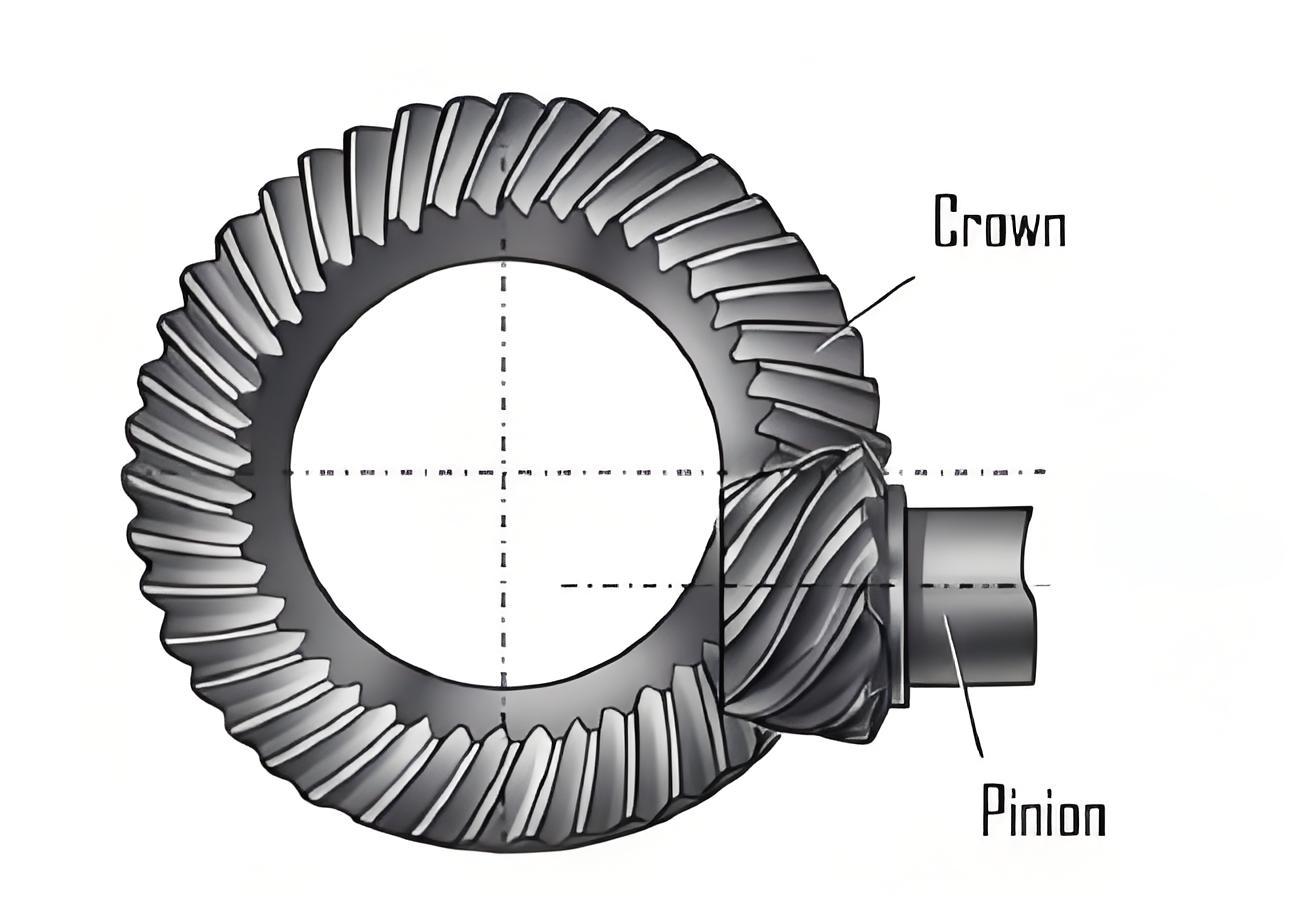This paper presents a systematic approach for optimizing the meshing efficiency of face-hobbed hypoid gears through friction-loaded tooth contact analysis (FLTCA). By integrating multi-objective constraints and advanced surrogate modeling techniques, we establish a robust framework for improving power transmission performance while maintaining structural reliability.
1. Tooth Surface Design Methodology
The design of hypoid gear tooth surfaces requires simultaneous optimization of convex and concave flanks. The fundamental equations governing tooth surface generation are:
$$
\begin{aligned}
r_2 &= f_r(\theta_d, \phi_d, \xi_c) \\
n_2 &= f_n(\theta_d, \phi_d, \xi_c)
\end{aligned}
$$
Where $r_2$ and $n_2$ represent radial and normal coordinates respectively. Misalignment compensation uses transformation matrices:
$$
M_1 = \begin{bmatrix}
1 & 0 & 0 & \Delta P \\
0 & 1 & 0 & \Delta W \\
0 & 0 & 1 & \Delta E \\
0 & 0 & 0 & 1
\end{bmatrix}, \quad
M_2 = \begin{bmatrix}
\cos(\Delta\Sigma) & \sin(\Delta\Sigma) & 0 & 0 \\
-\sin(\Delta\Sigma) & \cos(\Delta\Sigma) & 0 & 0 \\
0 & 0 & 1 & 0 \\
0 & 0 & 0 & 1
\end{bmatrix}
$$
| Parameter | Pinion | Gear |
|---|---|---|
| Number of Teeth | 10 | 39 |
| Shaft Angle (°) | 90 | |
| Offset (mm) | 30 | |
| Spiral Angle (°) | 44.0 | 30.8 |

2. FLTCA-Based Optimization Framework
The multi-objective optimization problem for hypoid gear efficiency enhancement is formulated as:
$$
\begin{aligned}
&\text{Find } \{k_c, b_c, P_{TE,c}, k_v, b_v, P_{TE,v}\} \\
&\text{Maximize } \eta \\
&\text{Subject to:} \\
&\quad P_{LTE} \leq 50\mu rad \\
&\quad \sigma_{pc}, \sigma_{pv} \leq 3300MPa \\
&\quad \Delta S_c, \Delta S_v \leq 1mm^2 \\
&\quad 3 \leq k_c, k_v \leq 8 \\
&\quad 0.2 \leq b_c, b_v \leq 0.3 \\
&\quad 0.00008 \leq P_{TE,c}, P_{TE,v} \leq 0.00012
\end{aligned}
$$
The hybrid lubrication friction coefficient model combines boundary and fluid lubrication effects:
$$
\begin{aligned}
\mu_{ML} &= \mu_{FL}f_\lambda^{1.2} + \mu_{DC}(1-f_\lambda) \\
f_\lambda &= \frac{1.21\lambda^{0.64}}{1+0.37\lambda^{1.26}}, \quad \lambda = \frac{h_0}{S}
\end{aligned}
$$
3. Surrogate Model Implementation
The Kriging surrogate model with Expected Improvement (EI) criterion accelerates optimization:
$$
\begin{aligned}
Y(X) &= f(X)\beta + Z(X) \\
\text{E}[I(x)] &= \begin{cases}
(f_{min}-\hat{y})\Phi\left(\frac{f_{min}-\hat{y}}{s}\right) + s\phi\left(\frac{f_{min}-\hat{y}}{s}\right) & s>0 \\
0 & s=0
\end{cases}
\end{aligned}
$$
| Parameter | Initial | Optimized | Improvement |
|---|---|---|---|
| Power Loss (W) | 1476.4 | 1182.7 | 19.8% |
| Efficiency (%) | 96.32 | 96.72 | +0.4% |
| Contact Stress (MPa) | 3076.6 | 2964.7 | 3.6% |
4. Experimental Validation
Full-scale testing of optimized hypoid gears demonstrated significant improvements:
$$
T_{\text{loss}} = T_{\text{in}} – T_{\text{out}} = \sum_{i=1}^m \sum_{j=1}^n (F_{fij} + F_{Nij})r_{ij}
$$
The test results confirm the effectiveness of the proposed optimization methodology in practical applications, particularly under high-load operating conditions.
5. Conclusion
This study establishes a comprehensive framework for hypoid gear optimization through:
- Integrated FLTCA modeling considering mixed lubrication
- Multi-objective constraint handling
- Efficient surrogate model-assisted optimization
The methodology demonstrates 0.4-1.2% efficiency improvements in real-world applications while maintaining structural integrity and NVH performance requirements.
